ACEC Cobra armored personnel carrier (Belgium)
The first prerequisites for the emergence of the future Cobra project appeared in the sixties of the last century. The Belgian company Ateliers de Constructions Electriques de Charleroi (ACEC) from Charleroi had considerable experience in the development and production of various electrical equipment, and at that time decided to use it in the field of armored combat vehicles. On its own initiative, the company began developing electrical transmissions for tracked vehicles. Developments of this kind in the future could find application in the projects of machines of different classes.
To "Cobra"
In 1970, the new program gave a real result. ACEC has upgraded the M24 Chaffee serial light tank using its own electric transmission. With the help of this technology demonstrator, ways to further develop the project were identified. Work continued, and in 1978, an AMX-10P armored vehicle without a manual transmission was brought to the test site. The rebuilt armored personnel carrier showed the necessary characteristics and qualities, opening the way to a completely new project.
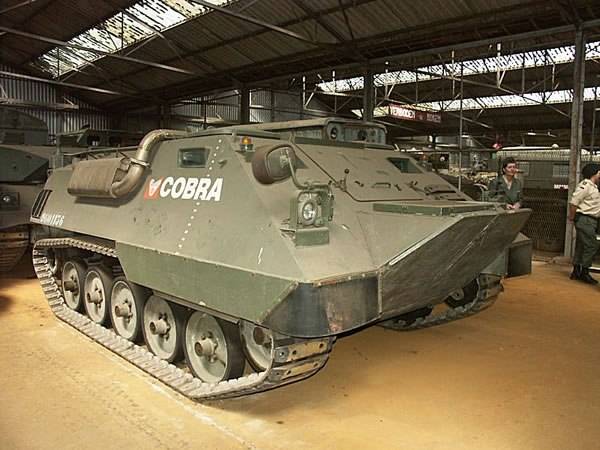
One of the museum samples BTR Cobra
After creating and testing two prototypes, ACEC also, as an initiative, began developing a completely new project. The designers decided to create a tracked armored vehicle, from which it was then possible to make a universal platform. The project called Cobra provided for the construction of a tracked chassis with a diesel engine and electric transmission, which was first to be the basis for an armored personnel carrier. Then it was planned to build an infantry fighting vehicle, a light tank, multiple rocket launcher system, etc. on such a chassis.
The base model of the new family was to be a promising armored personnel carrier. Its development began in the 1977 year and was conducted with the participation of the Belgian armed forces. The command expressed interest in the proposed project and provided some assistance. First of all, the Belgian army has developed and introduced tactical and technical requirements for the future Cobra. Thus, as soon as the project was launched, ACEC could consider the army as a possible customer.
Already in 1978, ACEC worked on the main points of the project and built a mock-up sample called Cobra P1. This machine had only the most necessary units, and its body was made of structural steel. Such a prototype actually was a technology demonstrator and had a limited role. Nevertheless, he passed the necessary tests and showed which solutions in the context of the power plant and transmission have the right to life, and which solutions should be discarded.
In 1980, two prototypes went to the test site at once - P2 and P3. Outwardly, they differed little from the P1, but in their design completely corresponded to the developed project. By this time, engineers from ACEC completed the formation of the shape of the future platform, and later it did not undergo significant changes. All subsequent prototypes most resembled the products Cobra P2 and P3. However, from a certain time the number of differences began to grow, which was associated with the development of "Cobra" as a carrier platform for various means.
Design
The project involved the construction of a welded armored hull with a protection not more than a few millimeters thick. The corpus had to withstand a non-armored bullet hit by the NATO 7,62x51 mm NATO cartridge from all angles at any range or armor-piercing from the front corners. Protection against 105-mm artillery shells was also provided. The possibility of installing an additional reservation was not provided.
The body of the ACEC Cobra BTR had a recognizable appearance. Its front part was formed by several rectilinear sheets and had a characteristic protruding “nose”. In addition, due to the special layout of the hull, the commander and driver places had to be smashed to the sides, which also affected the exterior. The hull sides consisted of several parts and formed fences niches. Above, there was a horizontal roof with sloping side portions, at the back - a stern sheet with an opening under the door.
The front of the hull accommodates the engine compartment and the workplaces of two crew members. The engine was placed in the center of the car, and therefore people had to move as much as possible to the sides. Almost all the remaining hull volume was given to the troop compartment. Under its floor, in the stern, there were two electric motors connected with driving wheels. The refusal of the mechanical transmission led to the release of volumes, and also made it possible to reduce the size of the body.
The first three Cobra prototypes were completed with Cummins VT series diesel engines with HP 143 power. Instead of a clutch and gearbox, an alternating current generator with a rectifier was connected to them. Through the control system, the current was applied to two traction motors. Especially for the new chassis, ACEC has created an engine with the required characteristics, as well as a special gearbox for it. The latter was a two-stage onboard gear. One stage was intended for work on the highway, another - for movement on rough terrain.
Chassis ACEC Cobra did not differ complexity. On each side, five road wheels were placed with suspension on balancers with springs. Extreme pairs of rollers also had hydraulic shock absorbers. In front of the hull were guide wheels, in the stern - leading. Above the intervals between the support rollers were supporting. In the first versions of the project, the armored personnel carrier did not have separate means for movement in water and had to pick up speed by rewinding the tracks.
The BTR "Cobra" own crew was to consist of two or three people. The driver and commander were located in front of the hull, on the sides of the power unit; over them had their own hatches. To observe the road there were triplexes in the front and side sheets. The third crew member, the shooter, was supposed to work in the troop compartment and use the existing weapons.
Initially, along the sides of the troop compartment, there were two simple benches, each of which contained five people. Later equipment compartment improved. Ten paratroopers could get into the car or leave it through the stern door or through the sunroof. There were no loopholes for shooting from under armor, but there was a small window in the door.
From the very beginning, the Cobra project provided for the installation of various weapons. At the same time, in the early stages, such opportunities were not used very actively. On two prototypes there were two machine gun installations. One of them was installed on the roof hatch and equipped with a machine gun M2HB. In front of the commander’s place in the front plate there was a ball mount for an FN MAG machine gun. After working off the chassis, experiments began with other weapons, including increased power.
The car turned out to be compact, but not too light. The length slightly exceeded 4,5 m with a width of 2,75 m and a height on the roof of the 1,75 m. In the configuration of an armored personnel carrier with a machine-gun installation on the roof, the Cobra weighed about 8 t. Later, when creating new modifications of equipment, the mass could grow by a ton. The estimated speed on the highway reached 75-80 km / h, on the water - less than 5 km / h. Power reserve - 600 km.
New modernization
Cobra P2 and Cobra P3 prototypes confirmed the design characteristics, but did not fully suit the customer. In this regard, the improvement of the project began, according to the results of which, in 1984, a new car was launched for testing. In some sources, the fourth prototype is referred to as the Cobra P4. When it was created, the results of past tests and the wishes of the military were taken into account.
During the checks of the first prototypes, it was found that the existing engine does not cope with its tasks. Because of this, the Cummins VT190 190 hp engine was installed on the Cobra, which gave a serious increase in power density and related characteristics. Rewinding the tracks did not provide high performance on the water, and therefore two propellers appeared in the aft sheet of the hull in the annular canals. To use them, the existing electric transmission had to be modified.
During the tests, the fourth prototype of the Cobra showed higher performance. Thus, with the further development of the project and in the series should use a more powerful engine. Soon, in the 1985 year, the fifth prototype was built under the name Cobra 41, which had some differences from its predecessor. In fact, he became the benchmark for the planned production of serial equipment.
At the end of 1987, the seventh experienced armored personnel carrier - Cobra 42 - was brought to the test site. Its main differences from its predecessors consisted in the design of the hull. It was slightly modified to improve the performance on the water. For the rest, the 42 was identical to the 41 BTR.
Change weapons
The first ACEC Cobra prototypes were equipped with a pair of machine guns of various calibers. The 7.62-mm FN MAG was located on the frontal installation, and the 12,7-mm M2HB was mounted on the body roof. Already in the first half of the eighties, the developer company conducted a number of experiments involving the replacement of these weapons. The construction of the roof and the hatch in it made it possible to replace the existing armament and give the armored personnel carrier various possibilities - including turning it into equipment of other classes.
In order to increase the level of protection of the gunner-gunner, ACEC has developed a curious version of a turret machine-gun installation. The shooter was placed inside the dome with anti-bullet protection, while the machine gun remained outside. The 300 kg turret had electrical drives and provided fire in any direction with elevation angles from -10 ° to + 50 °. Provided for the use of an optical sight and searchlight. The tower could also be equipped with mounts for transport-launch containers with missiles of different types.
FN offered the RCDU (Remote Control Defense Unit) combat module. This product consisted of a U-shaped turntable and swinging unit with one machine gun M2HB or two FN MAG. Ammunition was 600 or 1500 cartridges, respectively. In one swinging casing with machine guns, it was proposed to install a television and thermal imaging camera.
Tests were conducted on an armored personnel carrier with an Oerlikon-Contraves GAD-AOA turret armed with an 20-mm automatic cannon. This tower had an open dome behind it and, above all, was intended for solving air defense tasks. In this case, the instrument could be used not only against air, but also against ground targets.
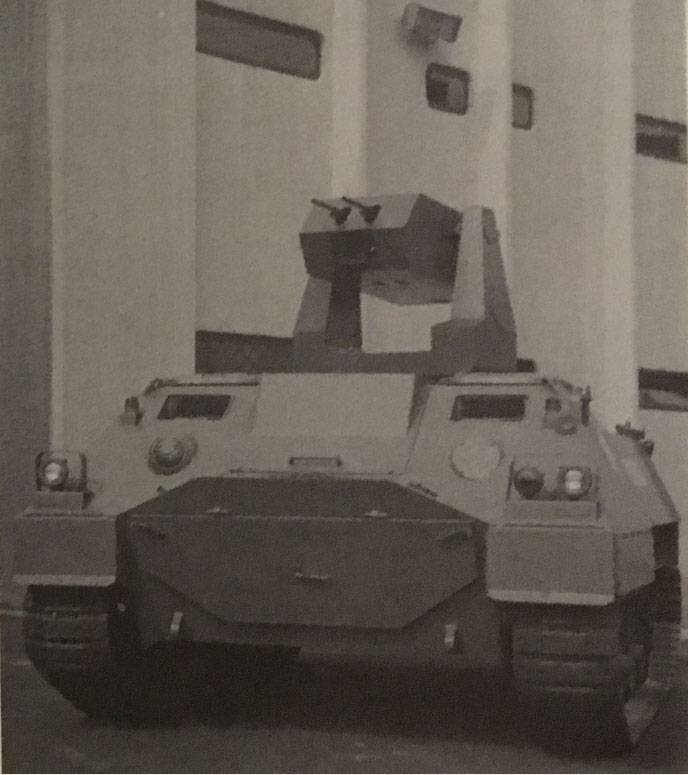
Cobra with RCDU module
Perhaps the most courageous version of rebuilding the Cobra was proposed in the project with the designation LAU97. In this case, a turntable with an 40 bag of 70 mm caliber guides was mounted on the roof of the case. Such a reactive salvo fire system was supposed to use FZ70 missiles. A product weighing just 4,3 kg carried 1 kg explosive and could fly 8 km. At the maximum range, a volley of missiles covered the zone of size 200 x 300 m.
Also, new armored vehicle designs based on the ACEC Cobra armored personnel carrier were proposed, which provided for not only the installation of new weapons. From an armored personnel carrier made a chassis for easy tank and a combat reconnaissance vehicle. In new projects, towers with 25 and 90 mm caliber guns were installed on a substantially redesigned case. At the same time, the machines retained the maximum possible unification with the base model.
Commercial failure
After the first tests of the fourth and fifth prototypes, the Cobra project was launched on the international market. ACEC demonstrated materials on the new project and prototypes at military-technical exhibitions in different countries of the world. In the near future orders could appear for the supply of serial armored vehicles.
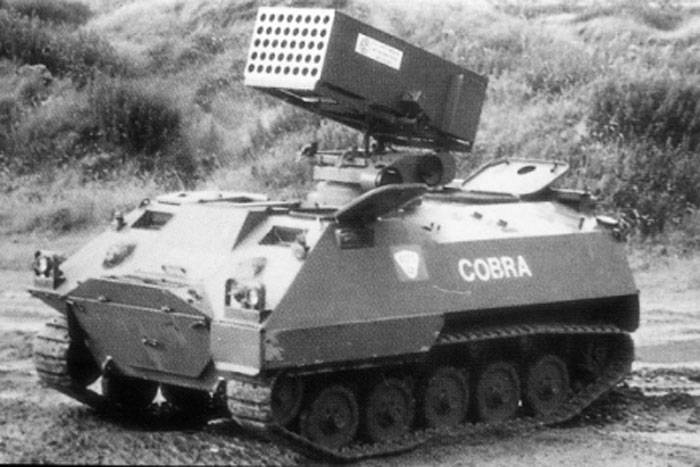
Armored personnel carrier with unguided missile launcher
As a start-up customer, the developer company expectedly considered the armed forces of Belgium. They participated in the development of the Cobra project and showed great interest in the proposed technology. In addition, the army even managed to conduct troop tests of some built prototypes. In the late eighties, ACEC believed that signing a contract with its own army was only a matter of time.
Entering the international market, the development company planned to interest small and poor countries wishing to re-equip, but not having the opportunity to purchase expensive samples from market leaders. For this reason, the Cobra cars were shown, first of all, at the main exhibitions in Asia.
In 1987, one of the most experienced armored vehicles was sent to the United States for testing at local test sites. American experts have carefully studied the submitted sample and left the best reviews. In its basic characteristics, an armored personnel carrier with an electric transmission was not inferior to similar models with units of the traditional type and, in general, corresponded to current requirements. A little later, similar tests were conducted in the United Arab Emirates. During this test, the ACEC Cobra car traveled about 2 thousand km in the desert.
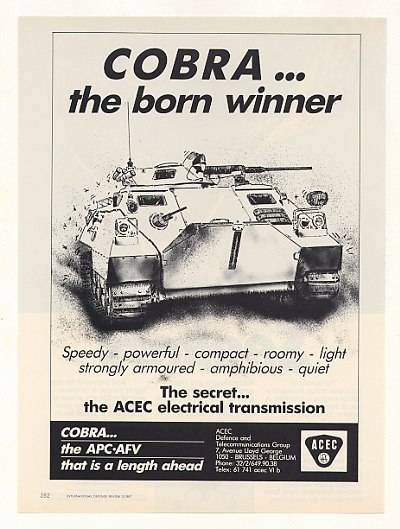
Advertising project ACEC Cobra. Unfortunately, unsuccessful
Probably, the new family of Belgian armored vehicles had good prospects in the market, but the changing situation in the world did not allow them to be realized. In the second half of the eighties, the military-political situation in the world began to change, and in the early nineties it became completely different. Traditional threats have disappeared, and many countries have sharply reduced their attention to security issues. This circumstance has affected the fate of many projects, including the Belgian Cobra.
In connection with the termination of the Cold War between the United States and the Soviet Union that collapsed, and also because of the normalization of the situation in Europe, the Belgian military decided to abandon the purchase of new armored vehicles. Other countries that previously showed interest in ACEC Cobra also made this decision. New customers did not appear, and a promising line of armored vehicles could not enter the series.
After the termination of the project, part of the built prototypes was disassembled as superfluous. At the same time, three cars were saved, now they are located in the branch of the Museum of the Royal Army and Military History in the city of Kapellen. Also in the museum is one of the experienced light tanks on the basis of "Cobra".
The ACEC Cobra family project involved the use of less common ideas and solutions that could be used to obtain the desired performance ratio. The finished sample was able to interest some potential buyers, but it did not go further. In the changed world there was no place for many promising armored combat vehicles, and among them were the Belgian developments of the Cobra family.
On the materials of the sites:
http://tanknutdave.com/
http://tanks-encyclopedia.com/
http://historyofwar.org/
http://dogswar.ru/
http://armyrecognition.com/
- Ryabov Kirill
- Tanks-encyclopedia.com, Tanknutdave.com, Tapatalk.com
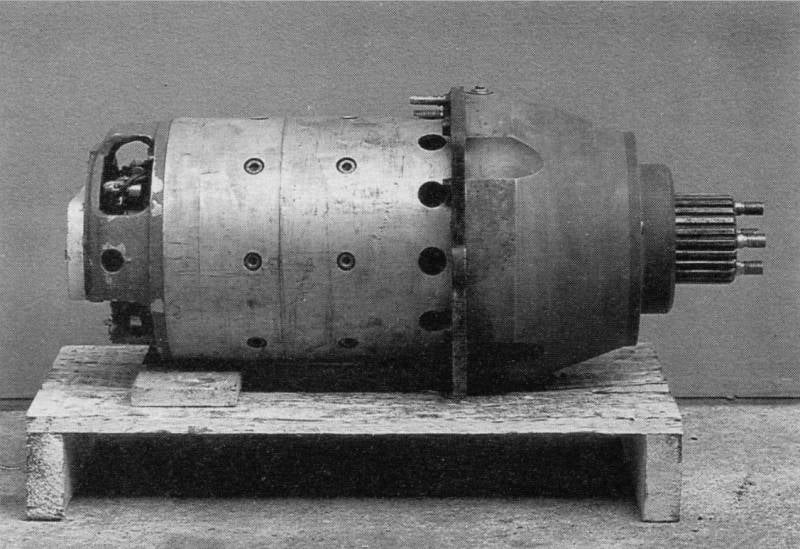
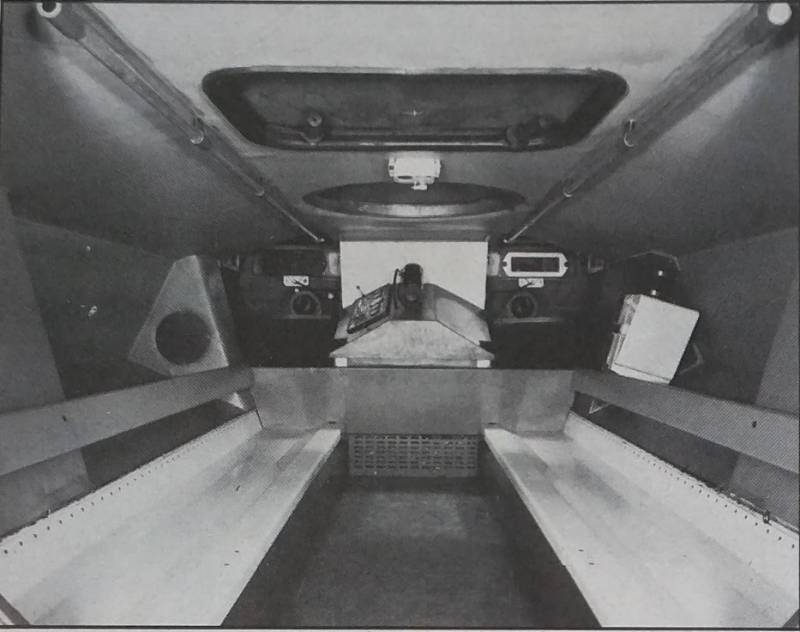
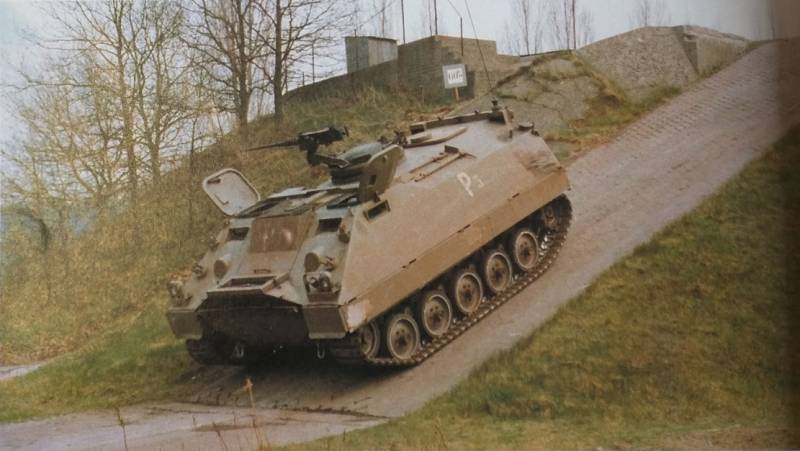
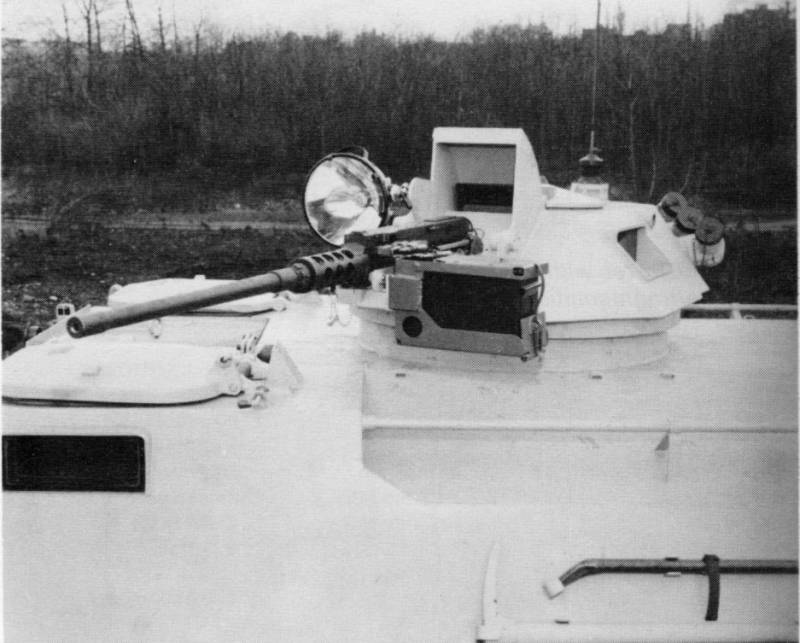
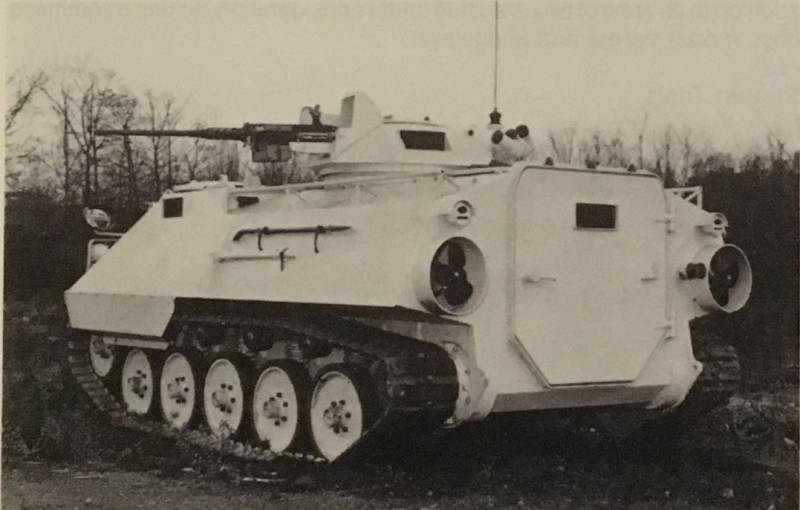
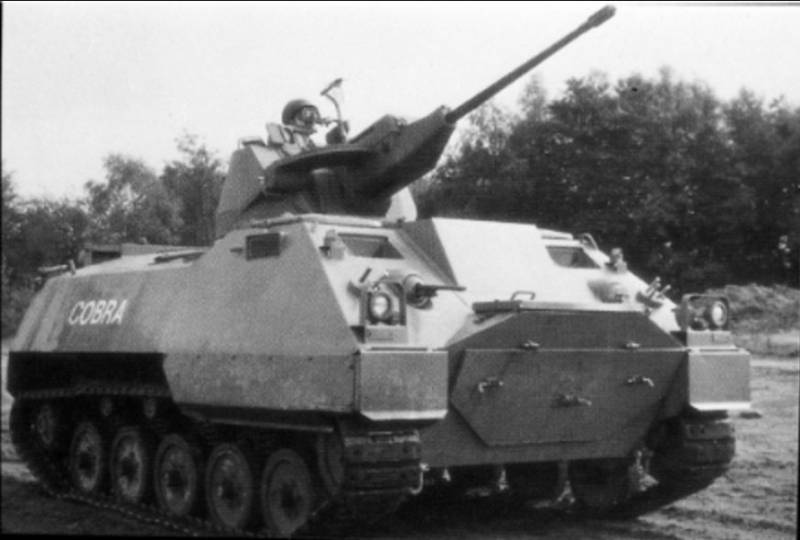
Information